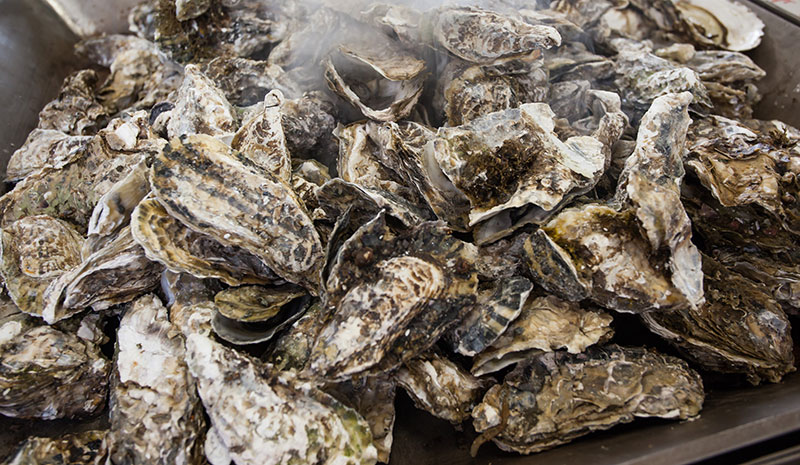Risks of Eating Steamed Oysters and Health Benefits: Things You Need to Know Going into Oyster Season in the Lowcountry
We are all excited in the Lowcountry about Oyster Season. Everywhere you turn restaurants and festivals are celebrating with buckets of oysters for all. Before you dive in, understand some of the possible risks and ways to reduce the occurrence of illness. Be safe and have a great oyster season.
Possible Bacteria
Each year, millions of Americans enjoy eating raw molluscan shellfish — especially oysters and clams. But if you have a liver disease, diabetes, or a weak immune system, raw oysters or clams containing the bacteria Vibrio vulnificus can make you seriously ill.
You can avoid illness simply by:
a.. Eating only oysters or clams that have been thoroughly cooked.
b.. Eating raw oysters or clams only if they are treated and labeled “Processed to reduce Vibrio vulnificus to non-detectable levels.”
What is Vibrio vulnificus?
Vibrio vulnificus is a bacteria that can cause sever illness or death to at-risk people who eat raw oysters or clams.
From 1989 to 2000, the U.S. Food and Drug Administration (FDA) recorded 282 serious illnesses associated with consumption of raw oysters and clams containing the Vibrio vulnificus bacteria. While illnesses are infrequent, about half (149) have resulted in death.
Where is it found?
Vibrio vulnificus is found naturally in warm coastal waters, such as the Gulf of Mexico, where levels of the bacteria are elevated during the summer months. Vibrio vulnificus is NOT a result of pollution, and can be found in waters approved for oyster and clam harvesting. Vibrio vulnificus does NOT change the appearance, taste, or odor of oysters or clams.
Are you at risk?
You are at risk of serious illness if you eat raw oysters or clams and have any of these health conditions:
a.. Liver disease (from hepatitis, cirrhosis, alcoholism, or cancer)
b.. Iron overload disease (hemochromatosis)
c.. Diabetes
d.. Cancer (including lymphoma, leukemia, Hodgkin’s disease)
e.. Stomach disorders
f.. Or any illness or medical treatment that weakens the body’s immune system

Side Effects of Eating Oysters
Allergic Reaction
About 3.5 to 4 percent of people worldwide suffer from food allergies, according to researchers at the University of Nebraska; a portion of these people have an allergy to shellfish, including oysters. Evidence presented in the 2008 issue of “Advances in Food and Nutrition Research” indicates that tropomyosin, a protein, is the allergen in oysters that triggers a reaction. Some side effects of eating oysters, both raw and cooked, when you have a sensitivity to tropomyosin include skin rashes and other skin problems, mouth or facial swelling and abdominal pain as well as more serious effects, such as anaphylactic shock that can lead to death.
Hemochromatosis
Oysters are quite high in iron – a 3-ounce serving contains 44 percent of the daily value. While getting the iron you need is important for your red blood cell count, people with hemochromatosis, a genetic condition that causes over-absorption of iron in your digestive tract, may need to avoid eating oysters so they don’t experience the adverse health effects associated with this condition, including abdominal pain, lethargy, loss of body hair and a change in your skin color.
Gastrointestinal Problems
Eating oysters may cause stomach problems, and not just from allergies or bacterial infections. Three ounces of oysters contain 67 milligrams of zinc, or 445 percent of the daily value. Even this quantity of oysters may be enough to trigger gastrointestinal reactions, since it is above the tolerable upper intake level of 40 milligrams per day. These reactions include vomiting, diarrhea and abdominal cramps. The problems caused by the zinc in oysters generally hit within three to ten hours of consumption and fade quickly after your zinc level returns to normal.
Bacterial Infection
It is best to determine where and when the shellfish were harvested — oysters picked in certain locations and times of year are more prone to make you sick because they can contain potentially dangerous bacteria. The Vibrio vulnificus bacterium lives in naturally warm coastal waters, and the number of these bacteria increases during hot summer months. However, this bacteria is present at all times of the year, so even oysters picked during the colder months can cause illness. Side effects of consuming oysters infected with bacteria include chills and fever, vomiting, diarrhea and skin reactions. You may also go into shock and die if the infection is not treated. People with certain medical conditions are at greater risk from infected oysters. Heat destroys Vibrio vulnificus, so one way to avoid eating this bacterium is to only eat properly cooked oysters.
Health Benefits
Aphrodisiac
As an aphrodisiac, oysters can help boost sexual performance and libido, primarily in men. The zinc content of oysters is nearly unbelievable. They contain more than 1500% of the daily requirements of this essential mineral in a single serving. Zinc has also been closely linked to sexual dysfunction in men, while impotence and erectile dysfunction are closely associated with zinc deficiency. Therefore, eating them can give men their sexual edge back and increase feelings of masculinity.
Weight Loss
Oysters represent one of the most nutrient-packed foods with the lowest calories versus the volume of serving size. This means that people trying to lose weight can keep their body packed with the nutrients it needs, without adding too much weight. Compared to an equal serving size of a chicken, oysters have nearly half the calories, and chicken breasts are often turned to for low-calorie, protein-rich meals. Oysters are far superior in this respect, but it must be noted that they do have a high content of sodium. So for people already suffering from obesity, oysters may exacerbate the problem.
Protein Content
Proteins are an essential part of our diet, and oysters are a very strong source. Proteins are often broken down by the body’s enzymatic activity and then reconstructed into usable human proteins in every part of the body. This ensures proper metabolic activity, tissue repair, cellular growth, muscle strength, and a wide variety of necessary aspects of human health. The importance of protein in the diet cannot be overstated, and a single serving of oysters provides nearly 1/3 of the daily requirement.
Protect Heart Health
Oysters can positively impact heart health in a variety of ways, but primarily the high levels of omega-3 fatty acids versus omega-6 fatty acids are what impact the cholesterol so greatly. Omega-3 fatty acids are known as “good” forms of cholesterol (HDL cholesterol), and the high ratio of “good” to “bad” (LDL cholesterol) (omega-6 fatty acids) makes them a major player in heart health. They can reduce the content of bad cholesterol in the bloodstream and inhibit it from binding to the blood vessels and artery walls. In this way, the chances of plaque accumulation are minimized and a variety of health complications, including cardiovascular diseases, says Dr. William S. Harris, Metabolism and Nutrition Research Center, University of South Dakota. Furthermore, the high potassium and magnesium content of oysters can help lower blood pressure and relax the blood vessels, thereby increasing circulation and oxygenation of the blood and reducing strain on the cardiovascular system as a whole. Finally, vitamin E in oysters increases the strength and flexibility of cellular membranes, which is the third level of protection against dangerous heart diseases.
Speed up Healing
Oyster has unprecedented levels of zinc, as per the Journal of The American Dietetic Association. This result in a number of health benefits, including quicker wound healing rates and a boosted immune system against various infections and microbes. As an essential mineral, zinc is also important for proper growth and development of children and adults, as well as the maintenance of bodily function for people of all ages.
Increase Blood Circulation
Oysters are also a very impressive source of iron, says Dr. Ralph G. Smith, ex-professor at the University of Michigan in his study. They contribute to more than 90% of our daily requirements in each serving. Iron is a key component in the formation of red blood cells in the body and is the primary defense against anemia, also known as iron deficiency, which can lead to fatigue, cognitive malfunction, stomach disorders, and general muscle weakness. Also, with a fresh supply of healthy blood cells in the circulatory system, organ systems have high levels of oxygenated blood to stimulate their activity, making them function efficiently and boosting the overall metabolic rate of the body.
Maintain Bone Health
The mineral content, as we’ve explained, is quite impressive in oysters, and is also a major contributor to the strength of your bones. The high levels of calcium, phosphorus, zinc, iron, copper, and selenium contribute in their own way to increase the bone mineral density and durability, thereby protecting you from developing conditions like osteoporosis. This is confirmed by a study published in Elsevier’s journal: Bone and Mineral.
Boost Immune Function
Boosting the immune system is yet another possible health benefit of eating oysters. The vitamin C and vitamin E content, as well as various minerals that have antioxidant and anti-inflammatory properties, are able to defend the body against free radicals that are byproducts of cellular metabolism. They can attack healthy cells and mutate the DNA into cancerous cells. These dangerous free radicals cause heart diseases, premature aging, and general body disrepair wherever they lodge themselves. Antioxidants and various vitamins can eliminate these free radicals from the body, thereby boosting the immune system.



